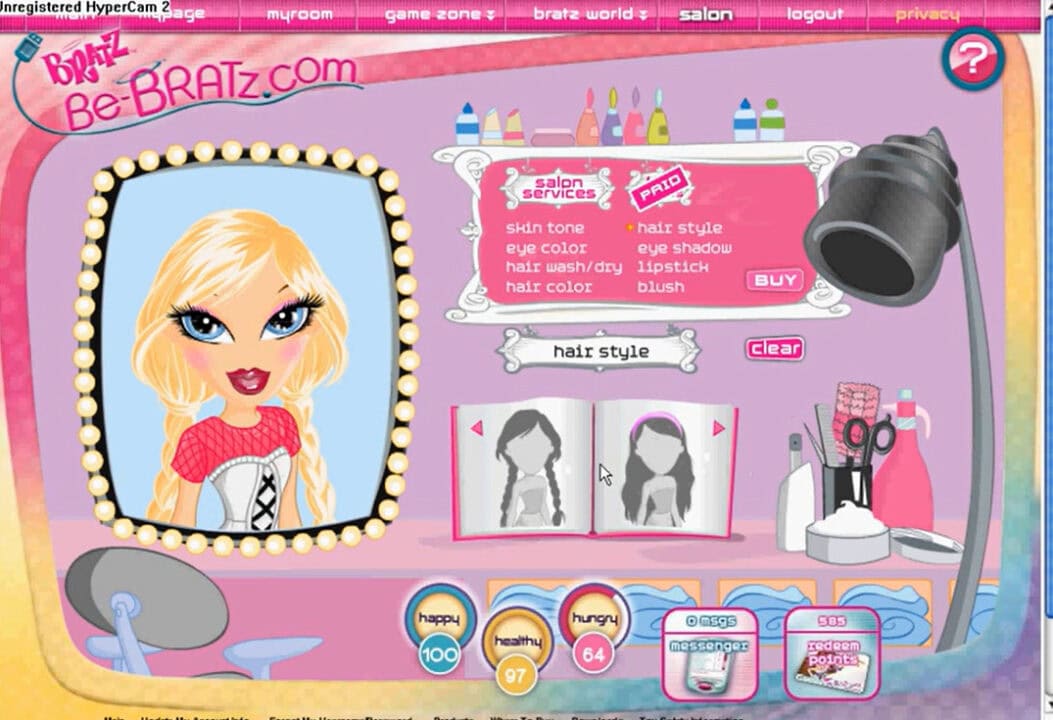
Our Forgotten Digital Dolls: A Note on Personalisation and Feminine Identity Crises
Once upon a time, the Internet was a playground for little girls. On BarbieGirls.com and Be-Bratz.com, we weren’t just dressing up avatars—we were learning how to present ourselves to the world. These virtual spaces taught us that to be seen was to be valued, planting seeds of self-scrutiny that bloomed into a full-blown obsession with image. Years later, the MP3 players and pink VIP badges are gone, but the mirror they handed us hasn’t cracked. We scroll, we compare, and we perform, still chasing that fleeting feeling of being enough in a world built to tell us otherwise.
TEXT
From BarbieGirls.com to TikTok, how the pastel innocence of virtual worlds shaped a generation’s obsession with self-image.
Written by Holly Mitchell
Oh, to relive the simplicity of the late noughties! A time when the biggest stressor in the lives of little girls with an Internet connection was deciding what to play when it was finally their turn on the family computer. It was exciting, wasn’t it? Being offered so many places where one could continue to chat and hang out with friends even after school. From the likes of Club Penguin to Moshi Monsters, there was truly something for everyone.
Christmas and birthday wish lists of the past included memberships to various online spaces, despite parental apprehension. Why put money towards something non-tangible that will be forgotten about in years to come?
For many, it may have had to do with what these exclusive purchases got for one’s virtual characters. Avatar customisation in games is not a new concept, but one that became crucial in so many of these virtual spaces. According to Simpleputpsych, the process of customising one’s very own avatar is an emotional investment, or a way to project themselves virtually. If the online space feels more catered to one’s real persona (physically or emotionally), then it is a no brainer that one would feel emerged in these pixelated spaces.
For little girls of the late 2000s, options for customisation were especially endless. Though many of these virtual hubs became closed over recent years due to the closure of Adobe Flash Player (the software that made such websites possible), they undoubtedly live on in the memories of the now-women who were once influenced by these sites. Funny, isn’t it? These beauty standards that were introduced digitally, with the catch that money needed to be spent to reap its rewards.

One iconic site that ceased to exist in 2011 was particularly known for this: BarbieGirls.com. Born in 2007, Mattel aimed BarbieGirls.com at young girls who could earn and use “B-Bucks” to create and customise a Barbie Girl (an avatar), play mini-games, go shopping, and host other players in their virtual room to hang out in. Mattel marketed this variation of a Barbie Girl as a modern fashion doll at the time, with a physical MP3 player that could be purchased to allow users a free VIP membership. Otherwise, VIP would cost $4.70 GBP for one month, $13.30 GBP for three months, or $23.50 GBP for six months. VIP items (such as hair, clothing, etc.) were stamped with the pink Barbie logo in the top right corner, which emphasised their exclusivity amongst the selection available to all users.
A lot of perks came with being a VIP Barbie Girl, including exclusive outfits, hair, and makeup selections that would match up the physical MP3 player and the online avatar. Here, further options were presented for young girls to personalise their virtual self. Naturally, VIP was what every user wanted to have. Big shout out to BarbieGirls.com for introducing countless young girls (myself included) to the concept of class conflict.

BarbieGirls.com also offered a VIP-exclusive customisation, where the user could display “Fab Facts” about themselves. These spread over several tabs on a Barbie Girl’s profile, where options to add their personality traits, their birthstone, and their home country were available. Subsequent tabs showed off each girl’s favourite colours, foods, school subjects, hobbies, sports, in-game hangouts, and what they wanted to be when they grew up! If that did not seem personalised enough, there was a customisation included that asked how Barbie Girl’s help the world, including user pledges to recycle and pick up rubbish!

All this detailed “fun fact” customisation that BarbieGirls.com had created was normal across all similar virtual spaces. Moshi Monsters, for example, had a diary available in the monster’s room where users could fill out and personalise their real moods, favourite colours, favourite foods, and favourite musicians. These detailed customisation features not only encouraged children to discover their sense of selves, but also understand how their personalities could be interpreted by others.
Be-Bratz.com was another immensely popular girly game, opposing its longtime competitor, Barbie. Like BarbieGirls.com, Be-Bratz featured a ridiculously detailed personality customisation page. A quiz was to be taken to determine if users were more shy or outgoing, more sassy or sweet, or more practical or dreamy (to name a few). Users could also showcase their favourite snacks, ice cream flavour, colours, accessories, school subject, and… smoothie flavour? Absurdly specific, but anything to get the girls perceiving themselves!

One major catch with Be-Bratz.com was that a physical doll had to be purchased to access the website. This was likely why no VIP or membership option was present in the Be-Bratz world, meaning everything was accessible if users had the in-game currency saved up (earned through mini-games). For example, in the Be-Bratz hair salon, it noted that everything had already been paid for – perhaps a cheeky middle finger to the parents that had bought the physical doll.

Playing in these virtual spaces at a young age, where there was such a heavy emphasis on looking beautiful and making friends, undoubtedly shaped how girls grew up with high expectations of their physical appearance and social standings in the late 2000s.
Instead of begging for memberships or VIP passes (apart from Roblox’s Dress to Impress), the young girls of today yearn for anti-ageing serums and expensive sunscreens (influencer-approved and bought in bulk after a TikTok haul), hoping to carve out their identity in the reflection of a hyper-curated screen. The beauty industry’s insidious knack for profiting off insecurities isn’t new, but what is truly disheartening is how these once-innocent online girly hubs, originally designed for connection and creativity, became breeding grounds for the self-obsession that plagues so many women today.
On websites like BarbieGirls.com and Be-Bratz.com, virtual exclusivity was currency. A sparkling membership badge or a rare outfit wasn’t just a marker of in-game status—it was the precursor to real-world hierarchies. These online spaces, with their hyperfocus on customisation, primed young girls to believe their worth lay in how they presented themselves. What started as harmless avatar dressing evolved into the perpetual anxiety of being seen, measured, and inevitably falling short.
These digital dollhouses weren’t just playgrounds; they were primers for performative femininity. Logging in after school wasn’t just about play—it was about competing in a silent, pixelated battle for relevance. We learned to compare, to envy, to perform. What began with choosing the perfect pair of sparkly boots for your avatar morphed into obsessively scrolling through perfectly lit selfies, searching for flaws or validation in equal measure.
The remnants of these dolly worlds persist in the algorithms we scroll past today. The pastel filters and rhinestone-studded aesthetics may be different, but the lesson remains: being a girl isn’t about who you are—it’s about how you’re seen. Now, as we look back at these seemingly innocent platforms, we see them for what they really were: a soft launch for the beauty industrial complex, packaged in bubblegum pink.
There’s a sadness to the nostalgia. The same girls who once played on BarbieGirls.com, trading outfits and crafting dream lives, are now women caught in the endless loop of self-optimisation. They’ve traded virtual outfits for IRL skincare routines, limited-edition eyeshadow palettes, and aesthetic clinic appointments, chasing that unattainable sense of enoughness.
The question lingers: were we ever playing? Or were we just rehearsing for a lifetime of looking? These dolly-world spaces offered us the fantasy of control, a brief illusion that we could curate our own perfect realities. But instead of empowerment, they left us with an obsession—one we carry now in the way we view ourselves, each other, and the endless mirrors of the digital age.
From BarbieGirls.com to TikTok, how the pastel innocence of virtual worlds shaped a generation’s obsession with self-image.
Written by Holly Mitchell
Oh, to relive the simplicity of the late noughties! A time when the biggest stressor in the lives of little girls with an Internet connection was deciding what to play when it was finally their turn on the family computer. It was exciting, wasn’t it? Being offered so many places where one could continue to chat and hang out with friends even after school. From the likes of Club Penguin to Moshi Monsters, there was truly something for everyone.
Christmas and birthday wish lists of the past included memberships to various online spaces, despite parental apprehension. Why put money towards something non-tangible that will be forgotten about in years to come?
For many, it may have had to do with what these exclusive purchases got for one’s virtual characters. Avatar customisation in games is not a new concept, but one that became crucial in so many of these virtual spaces. According to Simpleputpsych, the process of customising one’s very own avatar is an emotional investment, or a way to project themselves virtually. If the online space feels more catered to one’s real persona (physically or emotionally), then it is a no brainer that one would feel emerged in these pixelated spaces.
For little girls of the late 2000s, options for customisation were especially endless. Though many of these virtual hubs became closed over recent years due to the closure of Adobe Flash Player (the software that made such websites possible), they undoubtedly live on in the memories of the now-women who were once influenced by these sites. Funny, isn’t it? These beauty standards that were introduced digitally, with the catch that money needed to be spent to reap its rewards.

One iconic site that ceased to exist in 2011 was particularly known for this: BarbieGirls.com. Born in 2007, Mattel aimed BarbieGirls.com at young girls who could earn and use “B-Bucks” to create and customise a Barbie Girl (an avatar), play mini-games, go shopping, and host other players in their virtual room to hang out in. Mattel marketed this variation of a Barbie Girl as a modern fashion doll at the time, with a physical MP3 player that could be purchased to allow users a free VIP membership. Otherwise, VIP would cost $4.70 GBP for one month, $13.30 GBP for three months, or $23.50 GBP for six months. VIP items (such as hair, clothing, etc.) were stamped with the pink Barbie logo in the top right corner, which emphasised their exclusivity amongst the selection available to all users.
A lot of perks came with being a VIP Barbie Girl, including exclusive outfits, hair, and makeup selections that would match up the physical MP3 player and the online avatar. Here, further options were presented for young girls to personalise their virtual self. Naturally, VIP was what every user wanted to have. Big shout out to BarbieGirls.com for introducing countless young girls (myself included) to the concept of class conflict.

BarbieGirls.com also offered a VIP-exclusive customisation, where the user could display “Fab Facts” about themselves. These spread over several tabs on a Barbie Girl’s profile, where options to add their personality traits, their birthstone, and their home country were available. Subsequent tabs showed off each girl’s favourite colours, foods, school subjects, hobbies, sports, in-game hangouts, and what they wanted to be when they grew up! If that did not seem personalised enough, there was a customisation included that asked how Barbie Girl’s help the world, including user pledges to recycle and pick up rubbish!

All this detailed “fun fact” customisation that BarbieGirls.com had created was normal across all similar virtual spaces. Moshi Monsters, for example, had a diary available in the monster’s room where users could fill out and personalise their real moods, favourite colours, favourite foods, and favourite musicians. These detailed customisation features not only encouraged children to discover their sense of selves, but also understand how their personalities could be interpreted by others.
Be-Bratz.com was another immensely popular girly game, opposing its longtime competitor, Barbie. Like BarbieGirls.com, Be-Bratz featured a ridiculously detailed personality customisation page. A quiz was to be taken to determine if users were more shy or outgoing, more sassy or sweet, or more practical or dreamy (to name a few). Users could also showcase their favourite snacks, ice cream flavour, colours, accessories, school subject, and… smoothie flavour? Absurdly specific, but anything to get the girls perceiving themselves!

One major catch with Be-Bratz.com was that a physical doll had to be purchased to access the website. This was likely why no VIP or membership option was present in the Be-Bratz world, meaning everything was accessible if users had the in-game currency saved up (earned through mini-games). For example, in the Be-Bratz hair salon, it noted that everything had already been paid for – perhaps a cheeky middle finger to the parents that had bought the physical doll.

Playing in these virtual spaces at a young age, where there was such a heavy emphasis on looking beautiful and making friends, undoubtedly shaped how girls grew up with high expectations of their physical appearance and social standings in the late 2000s.
Instead of begging for memberships or VIP passes (apart from Roblox’s Dress to Impress), the young girls of today yearn for anti-ageing serums and expensive sunscreens (influencer-approved and bought in bulk after a TikTok haul), hoping to carve out their identity in the reflection of a hyper-curated screen. The beauty industry’s insidious knack for profiting off insecurities isn’t new, but what is truly disheartening is how these once-innocent online girly hubs, originally designed for connection and creativity, became breeding grounds for the self-obsession that plagues so many women today.
On websites like BarbieGirls.com and Be-Bratz.com, virtual exclusivity was currency. A sparkling membership badge or a rare outfit wasn’t just a marker of in-game status—it was the precursor to real-world hierarchies. These online spaces, with their hyperfocus on customisation, primed young girls to believe their worth lay in how they presented themselves. What started as harmless avatar dressing evolved into the perpetual anxiety of being seen, measured, and inevitably falling short.
These digital dollhouses weren’t just playgrounds; they were primers for performative femininity. Logging in after school wasn’t just about play—it was about competing in a silent, pixelated battle for relevance. We learned to compare, to envy, to perform. What began with choosing the perfect pair of sparkly boots for your avatar morphed into obsessively scrolling through perfectly lit selfies, searching for flaws or validation in equal measure.
The remnants of these dolly worlds persist in the algorithms we scroll past today. The pastel filters and rhinestone-studded aesthetics may be different, but the lesson remains: being a girl isn’t about who you are—it’s about how you’re seen. Now, as we look back at these seemingly innocent platforms, we see them for what they really were: a soft launch for the beauty industrial complex, packaged in bubblegum pink.
There’s a sadness to the nostalgia. The same girls who once played on BarbieGirls.com, trading outfits and crafting dream lives, are now women caught in the endless loop of self-optimisation. They’ve traded virtual outfits for IRL skincare routines, limited-edition eyeshadow palettes, and aesthetic clinic appointments, chasing that unattainable sense of enoughness.
The question lingers: were we ever playing? Or were we just rehearsing for a lifetime of looking? These dolly-world spaces offered us the fantasy of control, a brief illusion that we could curate our own perfect realities. But instead of empowerment, they left us with an obsession—one we carry now in the way we view ourselves, each other, and the endless mirrors of the digital age.

Enjoyed this story? Support independent gaming and online news by purchasing the latest issue of G.URL. Unlock exclusive content, interviews, and features that celebrate feminine creatives. Get your copy of the physical or digital magazine today!










